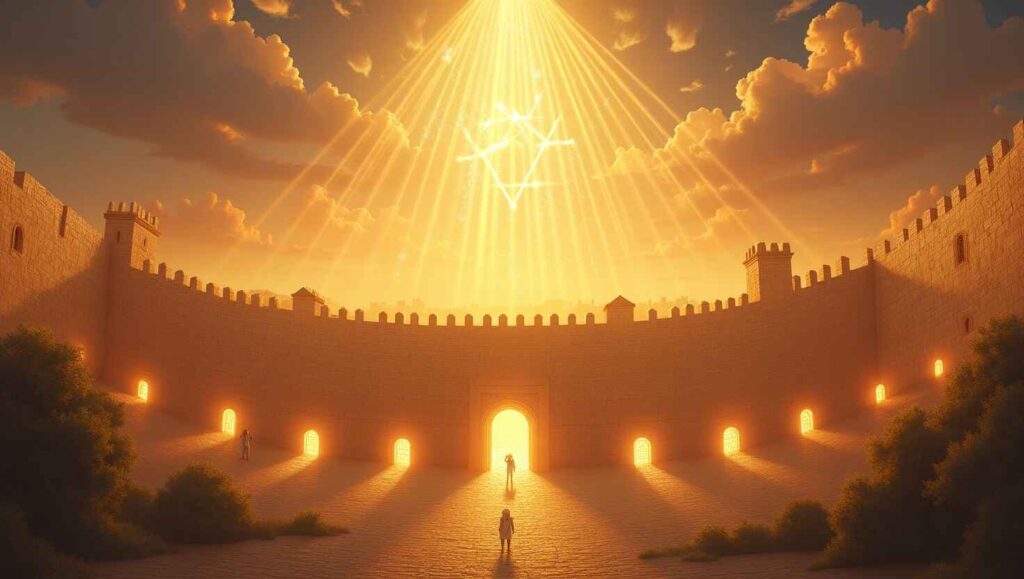Chapter 6: The Valley Gate – Embracing Humility and Brokenness
👉 Read Chapter 7: Jesus for Everyone to explore how Christ’s message touches every life with divine purpose.
In Nehemiah 3:13, the Valley Gate is listed among the gates of Jerusalem that were repaired during the city’s restoration. Though easily overlooked in the grand narrative of Nehemiah, the Valley Gate carries a profound message for every believer. Symbolically, it represents the valleys of life—places of testing, struggle, humility, and transformation. The Valley Gate is not a place of shame but a sacred space where God refines us. To walk through it is to learn that spiritual elevation only comes through descent. In this chapter, we will explore how the Valley Gate points to a deeper walk with God through brokenness, humility, and surrender.
1. The Valley Gate in Context
Located on the west side of Jerusalem, the Valley Gate opened to the Valley of Hinnom. This area was historically associated with suffering and judgment. Yet, in Nehemiah’s rebuilding efforts, even this gate was restored. This speaks volumes: God does not ignore or bypass our low places. He redeems them.
In life, valleys are inevitable. Psalm 23:4 says, “Even though I walk through the valley of the shadow of death, I will fear no evil.” Valleys may seem dark, but they are essential. They expose our need, confront our pride, and cultivate deeper dependence on God.
2. Humility Begins at the Valley Gate
True humility is not self-hate or weakness; it is clarity. It recognizes God as high and holy, and us as deeply in need of His mercy. The Valley Gate represents the beginning of this understanding.
Jesus modeled this in Philippians 2:5–8. Though fully God, He “humbled Himself” and took on the form of a servant. He descended into our world, into our pain, into our sin. If we are to follow Him, we too must pass through the Valley Gate.
3. Brokenness is Not the End
In Christian maturity, brokenness is not something to be avoided but embraced. David said in Psalm 51:17, “A broken and contrite heart, O God, you will not despise.” Brokenness opens our hearts to God’s healing. It removes the illusion of self-sufficiency.
Many of God’s greatest servants walked through valleys: Joseph in prison, Moses in the wilderness, Elijah under the broom tree, Paul with his thorn, and Jesus in Gethsemane. The Valley Gate reminds us that these moments are not detours—they are divine appointments.
4. Why the Valley Gate Is Necessary
The Valley Gate follows the Old Gate in Nehemiah’s sequence. This is no coincidence. After returning to ancient paths (Old Gate), the believer must go lower, not higher. The Valley Gate is where theology becomes experience.
The Christian life is not a constant ascent. It involves downward mobility in a world obsessed with platforms and power. Jesus said, “Whoever wants to be great among you must be your servant” (Matthew 20:26). We become spiritually strong by becoming low.
5. Personal Valleys and Their Purpose
Every believer walks through valleys: seasons of loss, sickness, discouragement, or spiritual dryness. These moments, though painful, are fruitful. They reveal who we are, but more importantly, who God is.
In the valley, idols are exposed, illusions shattered, and priorities realigned. The Valley Gate teaches us to trust when we cannot see, to obey when we do not feel, and to cling to God when everything else is stripped away.
6. How to Walk Through the Valley Gate
Walking through the Valley Gate requires intentionality:
- Surrender: Lay down pride and submit to God’s process.
- Honesty: Be transparent with God about your pain.
- Community: Don’t suffer in silence; share your journey.
- Worship: Praise becomes powerful in the valley.
- Patience: Valleys are temporary but transformative.
Don’t rush the process. Don’t despise the struggle. Let the valley do its work.
7. Christ in the Valley
Jesus, the Man of Sorrows, walked the ultimate valley. From His humble birth to His crucifixion, His life was marked by humility and brokenness. Isaiah 53:3 says, “He was despised and rejected by men, a man of sorrows, acquainted with grief.”
Yet, it was through this valley that salvation was secured. His resurrection came after the cross. His glorification came after Gethsemane. If Christ passed through the valley for us, we can trust Him to walk with us through ours.
8. Testimonies from the Valley
Many believers can trace their most significant growth not to mountaintop moments, but to valleys. It is in the valley that callings are clarified, gifts are discovered, and intimacy with God is deepened.
The Valley Gate becomes a portal of power, not just pain. It is the place where pride dies and purpose awakens.
9. Rebuilding the Valley Gate Today
The Church must restore this gate. In a culture obsessed with success and comfort, we must preach a Gospel that includes suffering, surrender, and sanctification. Discipleship must prepare people for the valleys, not just the victories.
Churches must become safe places for the broken, the grieving, and the weary. Leaders must model vulnerability. Revival will not come through hype, but through humility.
Conclusion: Beauty in the Broken
The Valley Gate stands as a symbol of sacred descent. It teaches us that God does His deepest work in our lowest places. To embrace humility and brokenness is not weakness—it is worship. In the valley, we see God more clearly and become more like Him.
May we not fear the Valley Gate but welcome it, knowing that the road downward often leads us higher in the Kingdom. For it is in the valley that our hearts are softened, our vision sharpened, and our faith purified. Let us walk boldly, knowing we do not walk alone.
The Valley Gate reminds us that spiritual growth often begins in the lowest places. Whether you’re experiencing personal trials, spiritual dryness, or emotional brokenness, it’s in these moments that God draws closest and shapes us most. In our Jesus for Everyone series, we dive deeper into how humility and surrender lead to transformation. For further reflection, Bible Gateway’s topical study on humility provides rich biblical insights into why valleys matter in the life of faith. Embracing the Valley Gate means allowing God to refine us—not in our strength, but in our surrender.

